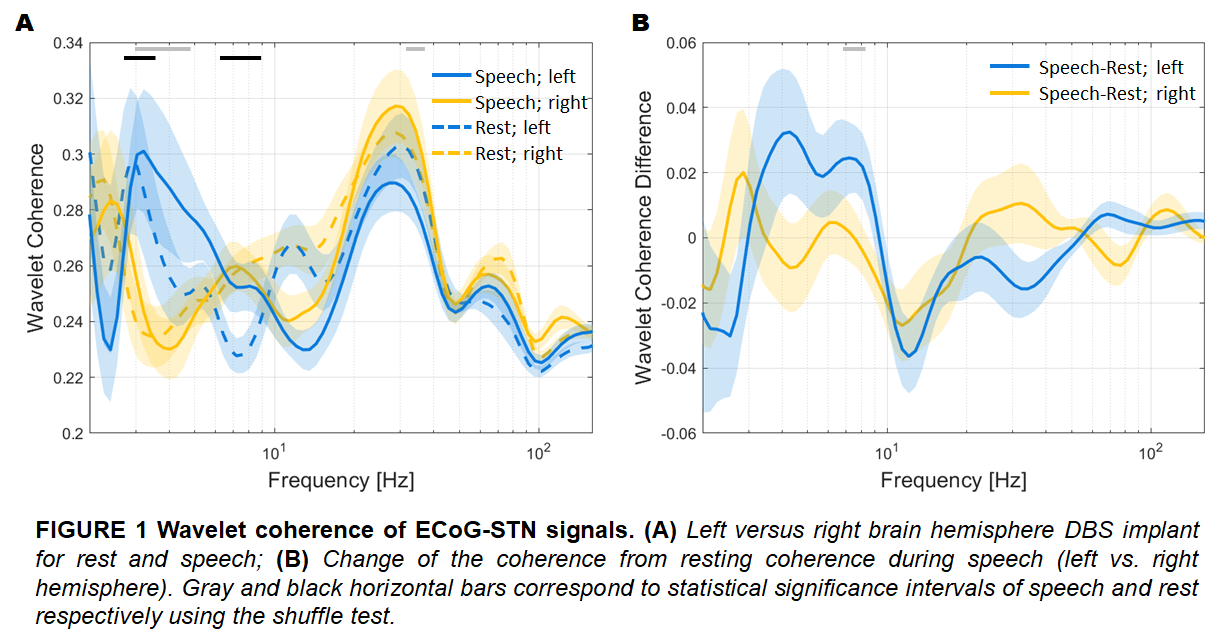Category: Parkinson's Disease: Non-Motor Symptoms
Objective: This study contrasts coherence between motor cortex and subthalamic nucleus (STN) field potentials across deep brain stimulation (DBS) implant hemispheres in patients with Parkinson’s disease.
Background: Language function is a well-recognized example of hemispheric lateralization in the human brain, however, knowledge of cortical-subcortical functional connectivity during speech is lacking. STN DBS is a well-established therapy for moderate to advanced motor symptoms but declines in verbal fluency and other speech abnormalities can occur following surgery. Therefore, greater knowledge on interactions between motor cortex and STN field potentials during speech behaviors is warranted.
Method: We recorded field potentials from directional STN DBS contacts and an electrocorticography strip placed temporarily over the motor cortex both at rest and during simple speech behaviors. Participants repeated a simple phrase multiple times within 10-second blocks matched with similar blocks at rest. Two rest and speech intervals were recorded per participant. We calculated motor cortex – STN coherence from the directional DBS contacts with Morlet wavelet coherence for the 2-160 Hz frequency range [figure 1], using 12 voices per octave, and 12 scales to smooth. Additional analyses evaluated event-related spectral perturbations on specific phonemes during speech.
Results: We studied 21 patients undergoing unilateral STN DBS surgery for Parkinson’s disease. Motor cortex – STN coherence was consistently increased in the beta range (20-30 Hz) independent of implant hemisphere. Initial findings indicate that theta frequency coherence (3-5 Hz) is enhanced in left versus right hemisphere implants at rest. This hemisphere-specific difference in cortical-subcortical coherence became more pronounced during repetitive speech behaviors.
Conclusion: Theta frequency coherence between motor cortex and STN differs by brain hemisphere at rest and during repetitive speech. Greater left hemisphere theta coherence is consistent with its known roles in speech and language production. Better understanding of brain networks involved in speech and communication could lead to novel therapeutic strategies to optimize speech and language function after surgery.
To cite this abstract in AMA style:
A. Nakhmani, R. Smith, V. Del Bene, M. Nelson, J. Olson, S. Brinkerhoff, Z. Irwin, J. Bentley, R. Knight, H. Walker. Left hemisphere theta coherence between cortex and STN increases during speech [abstract]. Mov Disord. 2023; 38 (suppl 1). https://www.mdsabstracts.org/abstract/left-hemisphere-theta-coherence-between-cortex-and-stn-increases-during-speech/. Accessed December 19, 2025.« Back to 2023 International Congress
MDS Abstracts - https://www.mdsabstracts.org/abstract/left-hemisphere-theta-coherence-between-cortex-and-stn-increases-during-speech/

